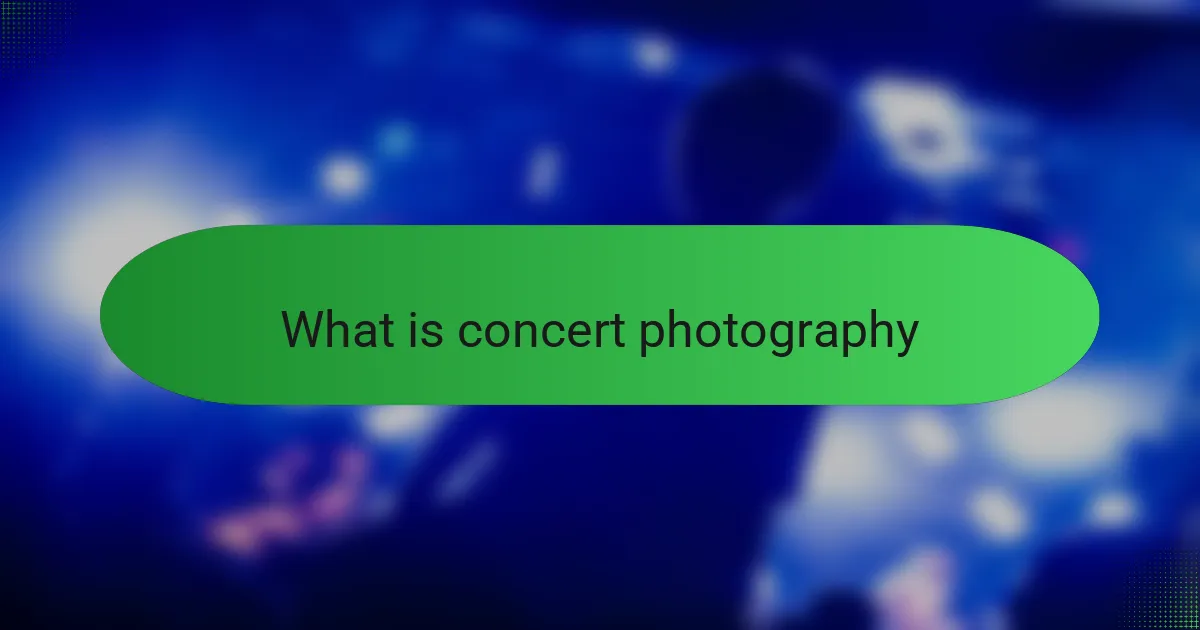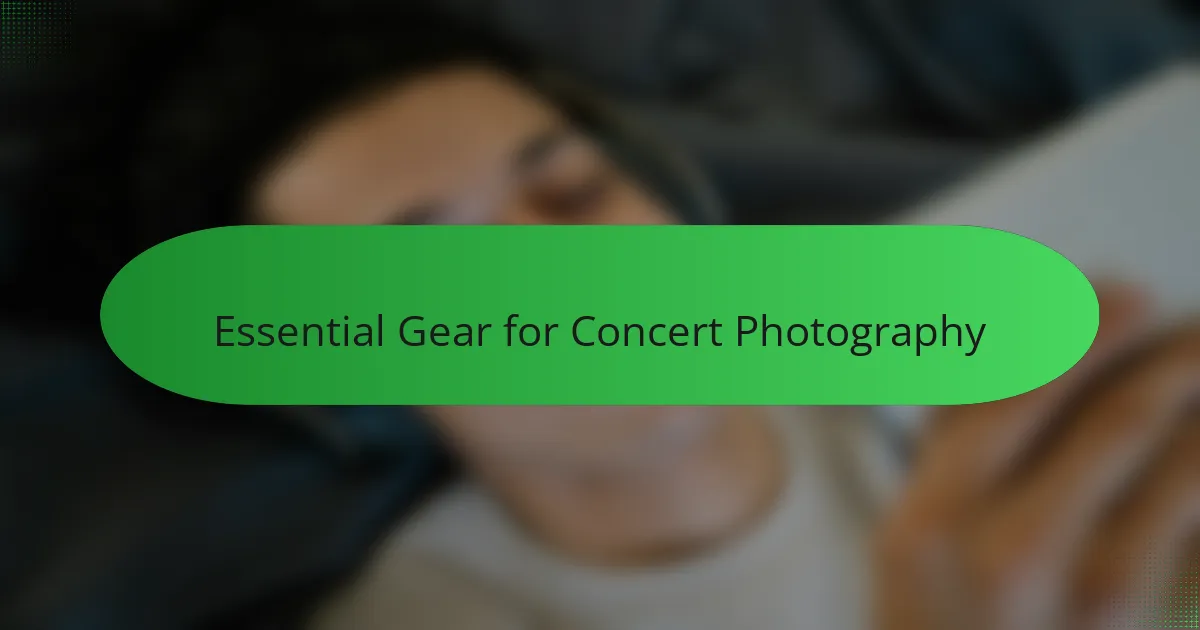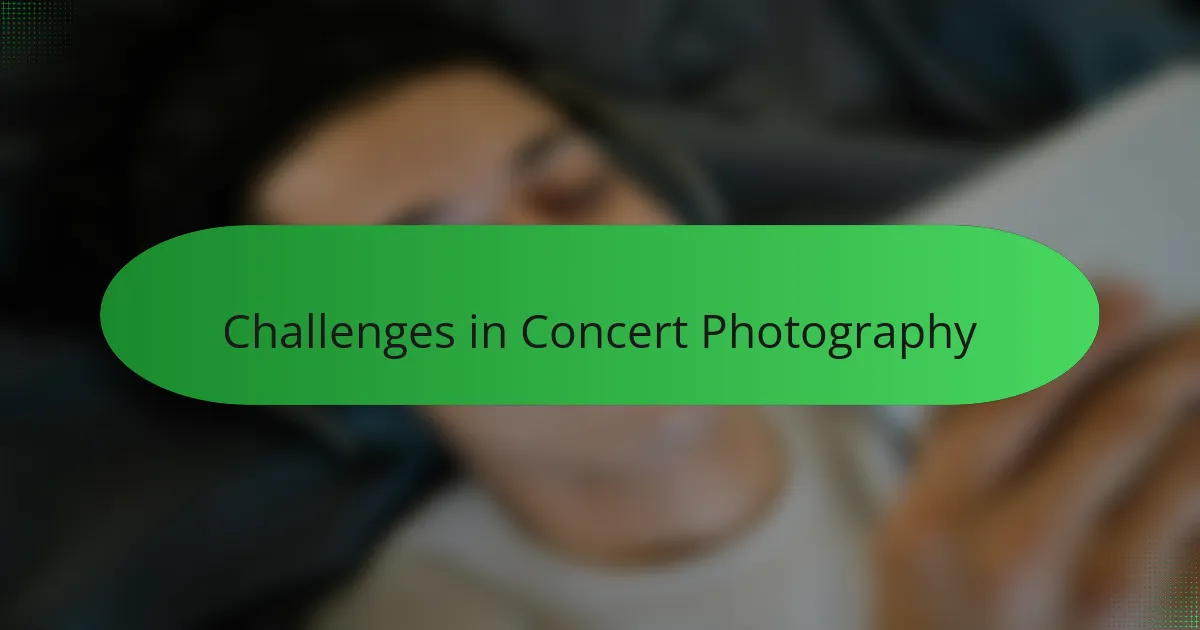Key takeaways
- Concert photography is about capturing the raw energy and emotional connection during live performances, showcasing moments that cannot be staged.
- Essential gear includes a fast lens, a reliable camera body for low-light conditions, and portability to adapt quickly in dynamic environments.
- Techniques such as anticipating movements, adjusting camera settings on the fly, and focusing on the connection between band members and the audience enhance the quality of shots.
- Well-captured concert photos enhance fanpages by creating immersive experiences, building community, and telling the band’s evolving story through dynamic imagery.

What Is Concert Photography
Concert photography, to me, is all about capturing the raw energy and passion that explode on stage during a live performance. It’s more than just snapping pictures; it’s about freezing those fleeting moments that make you feel the music deep in your bones. Have you ever seen a photo where you can almost hear the roar of the crowd or sense the sweat and intensity of the performers? That’s the magic concert photography strives to create.
When I think back to my first time doing concert photography, I remember feeling both thrilled and challenged. The unpredictable lighting, the fast movements, and the electric atmosphere make every shot a unique puzzle to solve. It’s this unpredictability that keeps me hooked—each frame tells a story that you couldn’t stage or replicate.
In essence, concert photography is an intimate dance between the artist, the audience, and the camera. It demands patience, timing, and a deep connection to the music because only then can you truly bring those electrifying moments to life on screen. Isn’t that what draws us so passionately to live shows in the first place?

Essential Gear for Concert Photography
When I first stepped into the chaotic world of concert photography, my gear felt like an extension of myself—without the right tools, I simply couldn’t capture the magic. A fast lens with a wide aperture became my best friend, allowing me to wrestle with low light and freeze those swift, electrifying movements on stage. Have you ever tried shooting in a dim venue without a lens that can handle it? It’s like trying to catch shadows with bare hands.
Beyond the lens, a reliable camera body that performs well in high ISO conditions makes all the difference. I’ve learned that chasing sharpness in the darkness requires equipment that won’t give up on you mid-show. And trust me, lugging around extra batteries and memory cards is just as essential—you never want to miss “the shot” because your gear betrayed you.
Tripods and flashes might sound tempting, but for me, they feel like obstacles in a crowded pit. Working handheld, blending into the crowd, is part of the dance. The gear I choose has to be versatile and lightweight, letting me move fluidly and focus on what really matters—the unpredictable, raw moments that no setup could script. Have you found your own “go-to” gear for concert chaos? It’s a personal journey worth undertaking.

Techniques for Capturing Rock Bands
Capturing rock bands live demands quick reflexes and an eye for those electrifying moments that flash by in an instant. I’ve learned to anticipate a guitarist’s wild solo or a vocalist’s powerful leap, positioning myself to catch that peak expression before it vanishes. Are you ready to trust your instincts and embrace the chaos? That split second can make or break the shot.
Lighting is always a tricky beast in concert photography, especially with rock shows that use strobe lights and shifting colors. I rely heavily on adjusting my camera’s ISO and shutter speed on the fly, balancing the aggressive stage lighting without losing detail or introducing too much grain. When the spotlight hits just right, those dramatic shadows and highlights tell stories louder than words ever could.
One technique I swear by is focusing on the human connection on stage—those moments when band members interact or the crowd reaches out. Zooming in tight to catch sweat, tattoos, or gritty expressions brings raw emotion into the frame, making the photos feel alive. Don’t be afraid to get close, physically and emotionally; it’s the intimacy that transforms a good shot into a legendary one.

Challenges in Concert Photography
Navigating the chaos of concert photography is like walking a tightrope without a safety net. I remember once trying to shoot my favorite band while dealing with constantly shifting stage lights that sent my exposure settings into a frenzy. Have you ever felt completely caught off-guard by a sudden blackout or a glaring spotlight? That unpredictability is part of the thrill but also a huge challenge.
Another hurdle for me has always been capturing sharp images in the midst of relentless motion. Musicians don’t pause for a photo—they jump, spin, and thrash with such intensity that freezing a crisp moment feels almost like catching lightning in a bottle. I’ve learned to embrace motion blur creatively, but still, getting that perfect sharpness when everything’s moving so fast is a tough puzzle.
Then there’s the crowd—an ever-present obstacle that can either add electric atmosphere or block your view entirely. I’ve found myself squirming and shifting just to find a clear line, all while trying not to annoy the fans around me. Doesn’t balancing respect for the audience with getting the shot feel like a delicate dance? It’s a challenge that keeps me humble and reminds me that concert photography is as much about people as it is about the music.

My Experience with Concert Photography
Concert photography has been a journey of growth for me. I recall my first major show, standing in the pit with my camera, heart pounding as the band launched into their opening riff. That rush of adrenaline as I captured the moment made all the late nights practicing with my gear feel worthwhile.
One thing that struck me over time is how every concert is its own beast. Some nights, the lighting can be brutally unforgiving, while others gift me with fleeting bursts of color and shadow that feel almost cinematic. How do you prepare for such unpredictability? For me, it means staying present and ready to adapt, which keeps the experience thrilling and fresh.
Also, I’ve come to appreciate the nuances—the way a guitarist’s sweat glistens under a spotlight, or how the crowd’s energy feeds the band’s performance. These intimate moments are what I chase with my lens, because they reveal more than just music; they capture the heartbeat of the show. Have you ever felt that connection through a single photograph? That’s the magic I strive to freeze in time.

Tips for Improving Concert Photos
One tip I can’t stress enough is to learn your camera settings inside out before the show starts. I’ve wasted precious seconds fumbling with menus when the band kicked off, missing what could’ve been killer shots. Have you tried setting your ISO, aperture, and shutter speed manually in advance so you can react quickly to changing lights? Trust me, that preparation lets you spend more time capturing the moment than tweaking your gear.
Another thing I’ve found helpful is to embrace the imperfections—sometimes motion blur from a wild guitar solo or grain from high ISO adds gritty authenticity to the photo. Early on, I used to get frustrated chasing perfect sharpness, but over time I realized those dramatic flaws often tell the story better than a crystal-clear image. Have you noticed how those raw moments convey the energy and chaos of live music in ways crisp photos can’t?
Finally, don’t forget to move around. Staying in one spot limits your viewpoint and the emotions you can capture. I used to stick close to the stage, but venturing into the crowd or backstage areas introduced me to completely new perspectives—intimate expressions, crowd interactions, and unexpected lighting that brought fresh life to my photos. When was the last time you tried reaching beyond the obvious to find that unique angle? It’s worth stepping out of your comfort zone.

How Concert Photos Enhance Fanpages
Concert photos transform fanpages into vivid time capsules, don’t they? When I scroll through a fanpage filled with dynamic shots from live shows, I feel instantly connected—as if I’m right there in the crowd, vibrating with the music’s pulse. These images breathe life into static pages, turning simple updates into immersive experiences that fans want to revisit again and again.
I’ve noticed that well-captured concert photos also build a sense of community on fanpages. Seeing familiar faces illuminated by stage lights, sharing moments of joy and intensity, reminds us all why we became fans in the first place. Have you ever clicked on a photo and suddenly felt the electric charge of a past concert rush back? That instant nostalgia deepens fans’ bonds with the band and with each other.
Beyond nostalgia, concert photos serve as storytelling tools that highlight a band’s evolving journey. Each image captures unique moods and milestones—whether it’s a raucous encore or a quiet backstage moment—that words alone can’t convey. From my experience, showcasing those genuine slices of live energy keeps a fanpage fresh and exciting, making every visitor feel like part of the ongoing rock story.